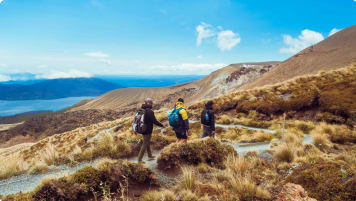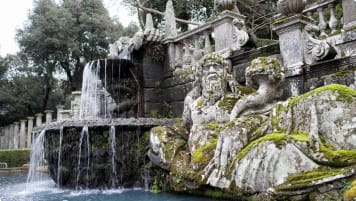Via de la Plata: Small Group Walking Tour in the Footsteps of Pilgrims
Visits to UNESCO World Heritage Sites introduced by local guides feature on this walking tour for mature couple and single travellers in central Spain. The days itineraries to selected destinations provide authentic experiences in central Spain. A single supplement is charged for solo travelers on these small group journeys.
From $13,558CAD

Highlights
- 1. Be amazed by the the ruins of the ancient Roman settlement of Italica.
- 2. Cross the kilometre-long Puente Romano, an important Roman bridge built in the first century.
- 3. Enjoy a stroll through Spain's oldest university, the University of Salamanca.
- 4. View the architectural marvels designed by Modernist architect Antoni Gaudi.

Departure Dates
| Departure Date | Price |
|---|---|
| 15 May 2025 Ends 03 June 2025 • 20 days $13,558 Twin $15,594 Single Available | Selected |
| 21 September 2025 Ends 10 October 2025 • 20 days $14,011 Twin $16,047 Single Available | |
| 14 May 2026 Ends 02 June 2026 • 20 days $14,283 Twin $16,319 Single Available | |
| 20 September 2026 Ends 09 October 2026 • 20 days $14,283 Twin $16,319 Single Available | |
| 06 May 2027 Ends 25 May 2027 • 20 days $14,737 Twin $16,773 Single Available | |
| 03 October 2027 Ends 23 October 2027 • 21 days $14,737 Twin $16,773 Single Available |
Via de la Plata Walking Tour
Odyssey offers easy, convenient, and relaxed escorted small group tours across Spain and beyond. We explore Spain's natural beauty, its ancient Roman, and Imperial heritage, its World Heritage Sites, and world famous cities, all with some truly spectacular scenery along the way on this walk. This and more is all waiting to be explored on one of Odyssey’s small group tours of Spain, designed for the senior traveller, and led by experienced, and enthusiastic like minded people.
Odyssey Traveller’s Via de la Plata Walking Tour will guide you on an unforgettable trip through the longest of the pilgrim routes in Spain, an ancient causeway that has been in use for centuries. This tour traverses Spain south to north, from the Andalusian capital of Seville to Leon, weaving through scenic rural countryside, lively cities, and places of historical significance.
This small group walking tour is rich in history and heritage, stopping in three towns included in the list of UNESCO Heritage sites—Mérida (listed in 1993), Caceres (1986), and Salamanca (1988). Seville, on its own, has three UNESCO Heritage sites listed in 1987.
Typically we will walk between 5 to 15 kilometres per day, and explore key places of interest with local guides along "The Silver Way". This program includes more than 25 admissions and entrances to places of interest along the way, as well as the services of 11 different local guides who will share their local knowledge and history of the place visited with you.
Walk "The Silver Way" with our Via de la Plata Walking Tour
Via de la Plata’s name translates to 'the Silver Way'or 'the Silver Route' and although the walk does follow an old Roman road toward metal mines in northern Spain, its name has nothing to do with the extraction or trade of this precious metal. The plata in its name most likely originates from the Latin platea (wide road) or the Arabic ballatta (road). It merges with the well-known and well-trodden Camino Frances, the route that goes across northern Spain from the Pyrenees to Santiago de Compostela.
Join us in tracing the footsteps of the Romans transporting goods and metal across the country, the Islamic forces advancing into northern Spain, and the Spanish taking back their territory during the Reconquista, returning the route to Christian pilgrims tirelessly making their way to the tomb of the apostle Saint James.
Below are some of the tour highlights:
Seville
You can’t ask for a better starting point for this journey than Seville. Founded as the Roman city Hispalis and now the capital of the Andalusia region, this lively and disarming city is itself a popular tourist destination. Forming a monumental complex in the heart of Seville are the UNESCO Heritage sites the Alcázar (fortress) of Seville, now the oldest royal palace still in use in Europe and the Seville Cathedral (or the Catedral de Santa María de la Sede), the largest Gothic cathedral in the world.
Just 10 kilometres outside Seville, directly on the route of the Via de la Plata, lies the ruins of the ancient Roman settlement of Italica, with beautiful mosaic floors and an impressive and well-preserved Roman theatre.
Zafra
Zafra sits at the foot of the mountains of the Sierra de Castellar. Zafra is dominated by two interconnected squares, the Plazas Grande and Chica, and its 15th century Alcázar, once used by the Dukes of Feria and now restored and converted into a hotel (the Parador de Turismo). Zafra shares architectural similarities with Seville, and is often referred to as “La Sevilla Chica” or “little Seville”.
Mérida
Mérida, the capital of the Extremadura region, was established by the Romans on the banks of the river at an important junction linking Salamanca with Italica. Its modern name is derived from its Roman title “Emerita Augusta”, after the Emperor Augustus. The strong Roman influences are very apparent in the city, from the bronze sculpture of Remus and Romulus suckling a wolf to the Roman theatre built for an audience of 6,000 still standing in this modern city.
Caceres
Caceres has a rich history reflected in the blend of Roman, Islamic, Gothic, and Italian Renaissance styles in its architecture. Originally a Celtic settlement, it was occupied by the Romans and named “Castra Caeclii” after one of its commanders. Its name is derived from the Arabic “Al Qazris”, the title bestowed by the Moorish forces who took over the city after the Romans.
Salamanca
Salamanca offers an exceptional skyline showcasing the Romanesque towers of its cathedral. It is home to the oldest university in Spain, the University of Salamanca, founded in 1134, and numerous museums and palatial buildings.
Zamora
Formerly the Roman town of Ocellum Duri, Zamora has several Romanesque churches and buildings that retained their original features. The Zamora Cathedral is hailed as one of the most important examples of Romanesque architecture in Spain, with its distinctive dome based upon Istanbul’s Hagia Sophia serving as a symbol of the city.
Astorga
Astorga was established by the Romans in 14 BC as Asturica Augusta. Astorga houses many architectural marvels, one of which is the late 19th century Episcopal Palace designed by the Modernist architect Antoni Gaudi, famous for his design of the Sagrada Familia church in Barcelona.
Leon
We end the tour in Leon, home to many notable historical buildings, including the iconic Leon Cathedral and the neo-Gothic Casa Botines, designed by Gaudi.
Articles published by Odyssey Traveller to prepare you for the Via de la Plata Walking Tour
- article on Selecting walking shoes for women
- article on footwear and walking shoes
- article on what to pack when travelling.
- article on maintaining muscle fitness in senior and mature age travellers
- article on selecting socks for walking
- article detailing six great short walks in Britain
- article on preparing for a walking holiday
- article on Pilgrim walks in Europe
- article on walking in there Lake District
Other articles of possible interest is this two-part post filled with travelling tips for seniors, an article on the many nifty gizmos and gadgets you can bring on your trips, and an important article about practising responsible travel.
Articles about Spain published by Odyssey Traveller
The following list of articles published by odyssey Traveller for mature aged and senior travellers to maximise their knowledge and enjoyment of Spain when visiting;
- 15 of the best places in Spain to visit.
- Travel notes for Barcelona
- Ten of the best books published on Spain
- Ten of the Best art galleries in Europe to visit.
External articles to assist you on your walk along the Via de la Plata (the silver way)
- What should I know about Walking Via de la Plata
- Meals on the Via de la Plata, advice on what to eat
- Selecting your coffee on the Via de la Plata
- UNESCO World Heritage sites of Spain.
The Camino (St James way) pilgrimage walk
Odyssey Traveller also offer this historic pilgrimage walk during the shoulder seasons, when the weather is good for walking and the crowds have eased. Via de la Plata and the Camino de Santiago are scheduled so you can enjoy both tours one after the other should you choose.
Other Odyssey Tours
Walking the Via de la Plata is only one of the many walking tours offered by Odyssey Traveller. These tours are designed for the active senior traveller to enjoy in a small group holiday and learning environment. You might also want to check out our other departures to Spain and Portugal.
For more details about this tour, click the ‘Top 5’ or ‘Itinerary’ buttons above! If you’re keen to experience this tour, please call or send an email. Or, to book, simply fill in the form on the right hand side of this page.
Gallery
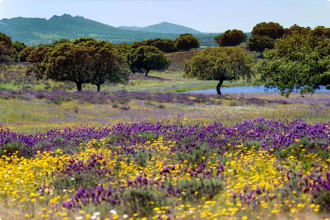
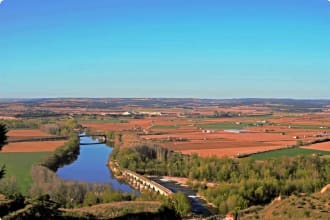

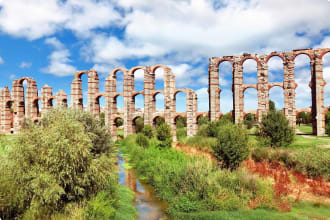
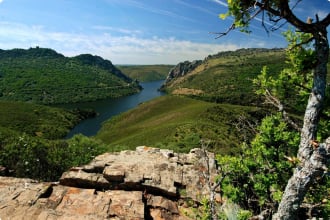


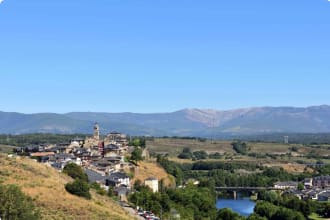
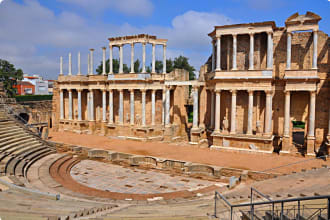
Itinerary
20 days
Day 1: SEVILLE
Accommodation: 3 Nights at the Hotel Fernando III or similar
Upon arrival at Seville, we will make our own way to the hotel. Remainder of the day is free. In the evening, we will come together to enjoy a welcome dinner.
Day 2: SEVILLE
Accommodation: 3 Nights at the Hotel Fernando III or similar
After a hearty breakfast, we will head out to view the UNESCO-listed World Heritage Site of Seville, the monumental complex in the heart of the city consisting of the Seville Cathedral with the Giralda minaret, the Alcázar (fortress), and the Archivo de Indias. The Seville Cathedral is the largest Gothic cathedral in the world with its Giralda tower standing at 96 meters. Once an Almohad mosque, it was turned into a Catholic Cathedral following the Reconquista in 1248 and now holds the remains of Juan of Aragon, son of Ferdinand and Isabella, and Christopher Columbus. The Alcázar (fortress) of Seville, imbued with Moorish influences, is the oldest royal palace still in use in Europe. The Lonja, which became the Archivo de Indias (General Archive of the Indies), contains valuable documents illustrating the reach of the Spanish Empire in the Americas and in Asia.
Day 3: SEVILLE
Accommodation: 3 Nights at the Hotel Fernando III or similar
Today we begin the walking stages of the tour. We will cross the bridge over Guandalquivir River, the longest river in the Iberian Peninsula, and enter Santiponce to view the 14th century San Isidoro del Campo Monastery, listed by Spain as a Historic Artistic Site of National Interest (Bien de Interés Cultural) in 1872. Built on the site of a Mozarab hermitage, it was said to be where San Isidoro was buried until he was moved to Leon in 1063. We will continue our walk and visit the ruins of the ancient Roman settlement of Italica, with its beautiful mosaic floors and an impressive and well-preserved Roman theatre (7 km).
We will have lunch after the tour and drive back to Seville to enjoy the rest of our day at our leisure.
Day 4: SEVILLE TO ZAFRA
Accommodation: Overnight at the Parador de Zafra - Palacio de los Duques de Feria or similar
We will travel from Seville to the municipality of Monesterio and walk to Arroyo del Bodion Chico (14 km), passing by picturesque grazing and cereal fields. From Arroyo del Bodion Chico we will drive to Fuente de Cantos for lunch (own arrangements) and if time allows, stop for a brief visit at the Casa Museo de Zurbaran, the house-museum of Francisco Zurbaran, a major painter of the Spanish Baroque era and an artist well-known for his religious artwork. After lunch, we will drive to Calzadilla de los Barros to visit the Parish Church of El Salvador which has one of the most beautiful and intricate Gothic altarpieces in the Extremadura region. From there we drive to Puebla de Sancho Perez for wine-tasting at the Bodegas Toribio. Finally we leave Seville and travel to the next stop on the Silver Way: Zafra.
Day 5: ZAFRA TO ALANGE
Accommodation: Overnight at the Gran Hotel Aqualange - Balneario de Alange or similar
We will take a pleasant stroll around Zafra in the morning, visiting the historic 16th century Colegiata de la Candelaria with its altarpieces created by Zurbaran, whom we’ve encountered in Seville, and renowned sculptor José Benito de Churriguera. We will walk around the Plazas Grande and Chica and view Zafra’s 15th century Alcázar, once used by the Dukes of Feria and now restored and converted into a hotel (the Parador de Turismo).
We will continue our walk to Los Santos de Maimona (5 km) to explore the town, enjoy some lunch (own arrangements), and visit the French Gothic Church of Nuestra Señora de los Angeles. We will hop on our touring coach and drive to Villafranca de los Barros, also known as the “City of Music” due to its long musical tradition, to view the local churches and the Plaza de Espana. We drive to Alange and end the day with a three-course dinner.
Day 6: ALANGE TO MERIDA
Accommodation: 2 Nights at the Parador de Merida or similar
From Alange we drive for a brief stop at the small and peaceful town of Torremejia, which has just a little over 2,000 residents. We continue on to the beginning of the walking path to Merida. From this starting point, we pass through agricultural fields and take the Puente Romano (9 km). The Puente Romano is an important Roman bridge built in the first century over the Guadiana River. The granite bridge stretches nearly a kilometre (or half a mile) and is supported by 60 arches.
We check in at our hotel and have lunch at a local restaurant. We take the afternoon off to nap, chat, or explore, until we meet again for dinner.
Day 7: MERIDA
Accommodation: 2 Nights at the Parador de Merida or similar
We spend the whole day exploring the city of Merida. We will view the Roman theatre built in the Classical style of theatres in Rome, for an audience of 6,000. Connected to the theatre through a tunnel is the Amphitheatre, which once witnessed gladiatorial combat and chariot races during the city’s days as a Roman territory. Another well-preserved Roman monument we will visit is the Roman Circus of Merida, which used to house 30,000 spectators. Near the river is the archaeological area of Moreria, which will give us an idea of the evolution of the city from Roman to modern times.
We will visit the Alcazaba, the Moorish fortification near the Puente Romano, to get a taste of Merida’s Islamic influences. We will view the mosaics and mural paintings inside Casa del Mitreo, the ruins of a Classical Roman house with connections to the cult of Mitra, followers of a secret religion which flourished in the Roman Empire from the 1st to 4th centuries. The nearby Los Columbarios will take us on a journey through the funerary rites and burials throughout the history of Mérida.
We will also visit the crypt of Santa Eulalia, the city’s patron saint.
Day 8: MERIDA TO CACERES
Accommodation: 3 Nights at the Gran Hotel Don Manuel Atiram Hotels or similar
Following breakfast, we will walk from Merida to Proserpina along the aqueduct called Los Milagros (“the miracles”) because of its impressive construction. The 10-km aqueduct was used to transport water from the Proserpina dam, an earth dam built by the Romans in the 1st century, to Merida. The end of our walk will allow us to view the earth dam so exquisitely built that it still stands today.
From Proserpina we will drive to Santa Lucia del Trampal in Alcuescar and visit its 7th century basilica, one of the few surviving Visigothic churches in the world. We will walk from the basilica to the town, where we will have free time for the rest of the afternoon. We then drive to Caceres and have dinner at the hotel.
Day 9: CACERES
Accommodation: 3 Nights at the Gran Hotel Don Manuel Atiram Hotels or similar
For the ninth day of the tour, we will explore Caceres. We will visit and view the vast collections inside Museo de Caceres. The museum is housed inside Casa de las Veletas (House of the Weather Vanes), a 16th century palace built on the site of a Moorish fortification, of which only the cistern (underground freshwater reservoir) remains. We will also visit the city’s religious centre, the Caceres Church Cathedral of Santa Maria, which has a 16th century altarpiece made of cedar and pine wood and dedicated to the Assumption of the Virgin Mary. It houses the chapel of the crucified Cristo Negro (Black Christ), the highlight of the Catholic procession in Caceres during Holy Week. We will view the Bujaco Tower, built by the Arabs in the 12th Century; the Arco de la Estrella, the entrance to the walled enclosure of medieval Caceres; and the Cave of Maltravieso , which has cave art dating back 64,000 years.
Day 10: CACERES
Accommodation: 3 Nights at the Gran Hotel Don Manuel Atiram Hotels or similar
Today we enjoy a day-long break from the tour. We will take this time to rest our feet to get ready for the upcoming walks.
Day 11: CACERES TO EL BARCO DE AVILA
Accommodation: Overnight at the Izan Puerta de Gredos or similar.
We return to the Silver Way on Day 11 with a drive from Caceres to Grimaldo, and a walk under the shade of cork oaks from Grimaldo to Riolobos (8 km). After a brief stop, we will drive to the charming Roman town of Baños de Montemayor, once the site of Roman baths with thermal waters said to provide remedy to those suffering from muscular and respiratory ailments. We will visit the modern spa Balneario Baños de Montemayor built on the old Roman baths, now with thermal swimming pools and a tropical shower and various beauty treatments on offer.
After a relaxing stay at the spa, we drive to La Calzada de Bejar where we can roam at our leisure, and finally travel to El Barco de Avila.
Day 12: EL BARCO DE AVILA TO SALAMANCA
Accommodation: 2 Nights at the NH Collection Salamanca Palacio de Castellanos or similar
From El Barco de Avila, we drive to Miranda de Azan, the starting point of our walk to the city of Salamanca (9 km). Salamanca offers its own, albeit smaller, Puente Romano to visitors entering its city, but despite being less imposing than its Méridan counterpart, Salamanca’s bridge offers an exceptional skyline showcasing the Romanesque towers of its cathedral. With a guide, we will walk and visit the city’s main attractions, including the Old and New Cathedrals of Salamanca and the Convento de San Esteban.
Day 13: SALAMANCA
Accommodation: 2 Nights at the NH Collection Salamanca Palacio de Castellanos or similar
We continue our tour of Salamanca, starting with the beautiful Plaza Mayor, the city’s large public square built in the Baroque style and lined with restaurants and shops. We will visit the aptly named Casa de las Conchas (House of Shells), its outer walls covered in more than three hundred shells which is a symbol associated with Santiago de Compostela. The Casa currently houses the city’s public library and an information office. Salamanca is home to the oldest university in Spain, the University of Salamanca founded in 1134, which we will visit as well to admire its architecture and know more about its history.
We will visit the Casa Lis Art Noveau and Art Deco Museum, which has a permanent exhibition of decorative arts dating from the end of the 19th century until World War II.
Finally, we will climb up the Puerta de la Torre, accessible through Salamanca’s New Cathedral, to enjoy a fantastic view of the city.
Day 14: SALAMANCA TO ZAMORA
Accommodation: 2 Nights at the Parador de Zamora or similar
On Day 14 we will drive to Aldeaseca de la Armuna, where we will begin our walk to the small town of Castellanos de Villiquera (5 km) where we will visit the church of San Juan Bautista and view its 16th century paintings and Renaissance carvings. From there we will drive to El Cubo de Tierra del Vino, where we will visit the church of Santo Domingo de Guzman and enjoy some free time to go to the underground wine cellar restaurants. We then drive to Zamora and have dinner before retiring for the night.
Day 15: ZAMORA
Accommodation: 2 Nights at the Parador de Zamora or similar
In Zamora, we will enjoy a full-day city tour. We will visit the Zamora Cathedral, hailed as one of the most important examples of Romanesque architecture in Spain, with its distinctive dome based upon Istanbul’s Hagia Sophia serving as a symbol of the city; the Castle of Zamora, dating back to the Middle Ages; and the Santa Maria Magdalena de Zamora, originally a church of the Templars dating back to the 12th century. We will also visit the seven-storey (with three floors built below street level) Castile-Leon Ethnographic Museum, a great way to learn about the culture, traditions, and history of the region.
Day 16: ZAMORA TO ASTORGA
Accommodation: Overnight at the Hotel Gaudi or similar.
We will bid goodbye to Zamora and drive to Castrotorafe to view the ruins of the Roman defensive site on the banks of the Esla River. This ancient town, with its castle well-preserved, is also known as “Zamora la Vieja” or “Old Zamora”. From here we walk and stop briefly at Riego del Camino (5 km), before driving to Granja de Moreruela to visit its 12th century monastery and to have lunch (own arrangements) in the town proper. After lunch, we drive to Astorga and enjoy the rest of the day at our leisure.
Day 17: ASTORGA TO LEON
Accommodation: 3 Nights at the Eurostars Leon or similar
For the first half of the day we will explore Astorga’s many architectural marvels, including the late 19th century Episcopal Palace designed by the Modernist architect Antoni Gaudi, famous for his design of the Sagrada Familia church in Barcelona. We will also visit the Astorga Cathedral (Catedral de Santa María de Astorga), its long process of construction (14th to 18th century) apparent in the blend of Renaissance and Baroque styles in the cathedral’s architecture. We will also visit the Museo del Chocolate where we’ll learn about the history of chocolate production, as well as the Roman Museum of Astorga.
After the tour, we will transfer to Leon.
Day 18: LEON
Accommodation: 3 Nights at the Eurostars Leon or similar
We go on a tour of Leon, founded by the Romans, once the seat of an independent kingdom, and witness to the first ever Parliament in Europe. Its rich history is mirrored in its wealth of historic buildings. Among those we will visit is the French-Gothic Leon Cathedral, and the fortress-like Casa Botines, designed by Gaudi. Right next to Casa Botines is the the Palace of the Guzamanes, the seat of the provincial government of Leon. We will also visit the Leon Museum, the colourful Museo de Arte Contemporaneo, covered in sheets of glass, and the old convent of San Marcos that is now a stunning luxury hotel, considered to be one of the most important Spanish Renaissance buildings in Spain.
Day 19: LEON
Accommodation: 3 Nights at the Eurostars Leon or similar
We will enjoy some leisure time which we can use to roam the city, do some shopping, or rest. In the evening we will have a farewell dinner at a local restaurant near our accommodation.
Day 20: LEON
The end of breakfast also marks the end of our services. Leon has good connections in terms of the main airports, with a direct train to Madrid and internal flights to both Madrid and Barcelona.
Tour Notes
- A high level of fitness is required for this tour.
- This tour will commence before and after the Camino de Santiago program also offered by Odyssey Traveller, with two (2) departures/year.
Includes / Excludes
What’s included in our Tour
- 18 nights of accommodation.
- 18 breakfasts, 4 lunches, and 10 dinners.
- Services of a Tour Leader for the duration of tour.
- Applicable entry fees and services of local guides.
- Gratuities and necessary tips.
- Detailed tour information booklet.
What’s not included in our Tour
- International flights and departure taxes.
- Comprehensive travel insurance.
- Items of a personal nature such as telephone calls and laundry.
Participants must be in excellent health, extremely mobile and live an active lifestyle. Program activities may include up to 6 hours of continuous strenuous, moderate-to-fast paced activities per day on varied terrain.
Book now
Make it a private tour
Easing your journey
Crossing international borders with restrictions
The list of requirements to travel internationally has changed and will continue to change for several years. Odyssey is here to assist you in managing your way through these requirements:
For more information see our Crossing international borders with restrictions page.
Book With Confidence
If less than 30 days before your tour starts you are unable to travel as a result of Government travel restrictions, Odyssey Traveller will assist you with a date change, provide you with a credit or process a refund for your booking less any non-recoverable costs.
See Terms and conditions for details.
Peace of Mind Travel
The safety of our travellers, tour leader, local guide and support staff has always been our top priority and with the new guidelines for public health and safety for keeping safe for destinations around the world, we’ve developed our plan to give you peace of mind when travelling with us.
See Peace of Mind Travel for details.
Reading List Download PDF
Pilgrimage: The Great Pilgrim Routes of Britain and Europe
Derry Brabbs
Pilgrimage in Europe is thriving on a massive scale. This century the cathedral at Santiago de Compostela alone has seen 40 times the number of pilgrim visits. Author Derry Brabbs’ previous book, Roads to Santiago, focused exclusively on the 'camino' through France and Spain to Santiago de Compostela; Pilgrimage revisits this classic route, and nine other inspirational journeys across Europe.
The Silver Way: China, Spanish America and the birth of globalisation 1565-1815: Penguin Specials
Peter Gordon
Long before London and New York rose to international prominence, a trading route was discovered between Spanish America and China that ushered in a new era of globalisation. The Ruta de la Plata or ’Silver Way’ catalysed economic and cultural exchange, built the foundations for the first global currency and led to the rise of the first ‘world city’. And yet, for all its importance, the Silver Way is too often neglected in conventional narratives on the birth of globalisation. Gordon and Morales re-establish its fascinating role in economic and cultural history, with direct consequences for how we understand China today.
Reconquest and Crusade in Medieval Spain
Joseph F. O'Callaghan
Drawing from both Christian and Islamic sources, Reconquest and Crusade in Medieval Spain demonstrates that the clash of arms between Christians and Muslims in the Iberian peninsula that began in the early eighth century was transformed into a crusade by the papacy during the twelfth and thirteenth centuries. Successive popes accorded to Christian warriors willing to participate in the peninsular wars against Islam the same crusading benefits offered to those going to the Holy Land. Joseph F. O'Callaghan clearly demonstrates that any study of the history of the crusades must take a broader view of the Mediterranean to include medieval Spain.
A Concise History of Spain
William D. Phillips Jr and Carla Rahn Phillips
The rich cultural and political life of Spain has emerged from its complex history, from the diversity of its peoples, and from continual contact with outside influences. This book traces that history from prehistoric times to the present, focusing particularly on culture, society, politics, and personalities. Written in an engaging style, it introduces readers to the key themes that have shaped Spain's history and culture. These include its varied landscapes and climates; the impact of waves of diverse human migrations; the importance of its location as a bridge between the Atlantic and the Mediterranean and Europe and Africa; and religion, particularly militant Catholic Christianity and its centuries of conflict with Islam and Protestantism, as well as debates over the place of the Church in modern Spain. Illustrations, maps, and a guide to further reading, major cultural figures, and places to see, make the history of this fascinating country come alive.
Ghosts of Spain: Travels Through Spain and Its Silent Past
Giles Tremlett
"Part modern social history, part travelogue, Ghosts of Spain is held together by elegant first-person prose...an invaluable book...[that] has become something of a bible for those of us extranjeros who have chosen to live in Spain. A country finally facing its past could scarcely hope for a better, or more enamored, chronicler of its present."-Sarah Wildman, New York Times Book Review
The appearance, more than sixty years after the Spanish Civil War ended, of mass graves containing victims of Francisco Franco's death squads finally broke what Spaniards call "the pact of forgetting"-the unwritten understanding that their recent, painful past was best left unexplored. At this charged moment, Giles Tremlett embarked on a journey around the country and through its history to discover why some of Europe's most voluble people have kept silent so long. In elegant and passionate prose, Tremlett unveils the tinderbox of disagreements that mark the country today. Ghosts of Spain is a revelatory book about one of Europe's most exciting countries.
The Story of Spain: The Dramatic History of Europe's Most Fascinating Country
Mark R. Williams
The book is a popular history of Spain and the Spanish Empire from prehistoric times to the present day. It provides description and analysis of political, social, economic and cultural events over the centuries, which together shaped the history of this distinctive country. The book offers 60 illustrations and maps, including 16 pages of color photographs, as well as lists of historic places to visit at the end of each chapter. There is a dynastic chart, suggested readings, and index.


